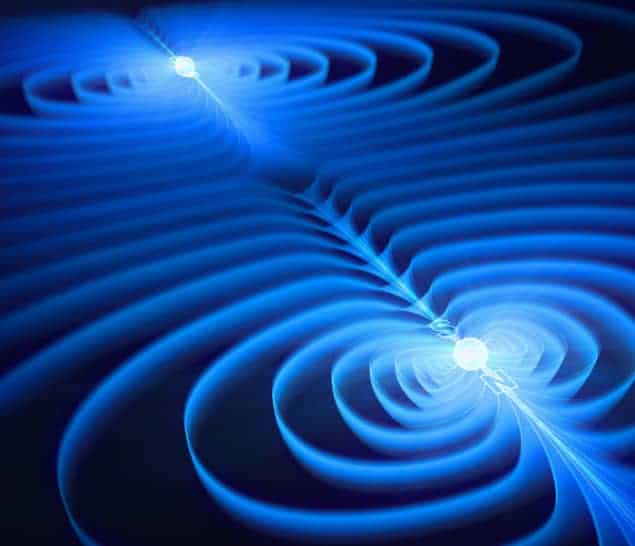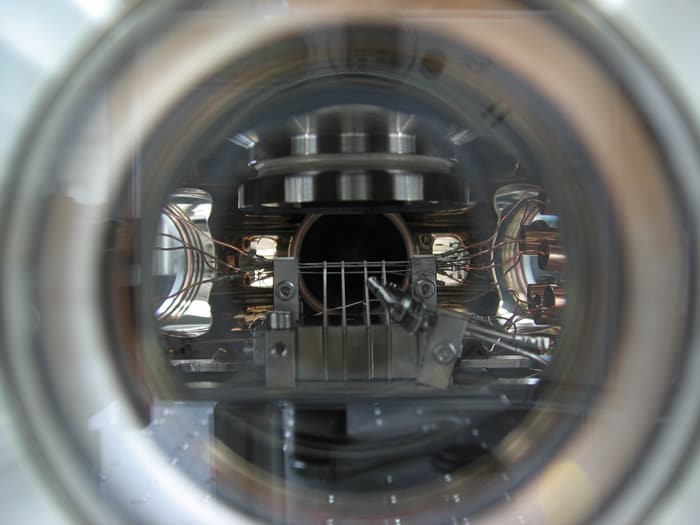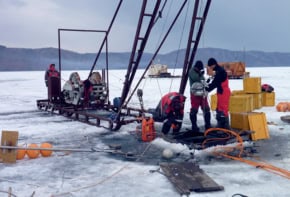
A measurement of the extremely weak magnetic interaction between two single electrons has been carried out by an international team of physicists. Using experimental techniques first developed for quantum-information and ion-trapping technologies, the team made its measurement despite the presence of magnetic noise, which is a million times stronger than the signal it was seeking. Apart from measuring magnetism at the shortest length scale thus far, the researchers say that their technique could be applied to other measurement scenarios where noise is a dominant factor, such as for quantum-error corrections.
Since the 1920s, researchers have known that the electron possesses an intrinsic angular momentum and an associated magnetic moment – known as its spin magnetic moment. Essentially, each electron acts like a tiny, indivisible magnetic dipole that is affected by magnetic fields. Although researchers have accurately measured the magnetic field of an individual electron, the magnetic interactions between two electrons have proved much more difficult to observe. When two electrons are separated by a very small distance (atomic-scale separations), the magnetic interactions are at their strongest and should be easy to measure. However, in this scenario Pauli’s exclusion principle and Coulomb electrical repulsion dominate the interactions between the electrons, drowning out the magnetic interaction. While these two effects weaken as the electrons move further apart, so does the magnetic interaction, which is then almost completely obscured by ambient magnetic noise.
Isolated interactions
One way of coping with this noise is to completely isolate the electrons from the environment – a technique that is often employed in quantum-information processing. This is the concept that Shlomi Kotler, from the Weizmann Institute of Science, Israel, and colleagues adopted to make their exquisite measurements. Indeed, Kotler says that the team’s measurement was performed at a scale “which is quite exotic – two microns. It is the size of an E. coli bacteria”, meaning that “the most dominant process is not of force between the electrons but of noise”. He further explains that the main tool used by the team to make its measurement was that of “decoherence-free subspaces” – a quantum-computing technique where a system is completely decoupled from its environment to protect information.
Kotler likens the difficulty of this measurement to trying to measure the size of a pea floating in the ocean, with huge waves of noise moving it erratically, across a distance of kilometres. While it would initially seem impossible to make the measurement (thanks to the pea’s constant movement), the trick would be to float alongside the pea. In that case, a wave would have the same effect on the pea and the observer, so that the effect of the waves would be inconsequential. In the researchers’ experiment, one electron is trying to sense the magnetic field of the other. “But that field is riding on top of magnetic noise in the lab, which is a million times bigger,” says Kolter. “The only way to make this measurement possible is to place the two electrons on an equal footing with respect to the ambient magnetic noise. This way, magnetic noise becomes irrelevant.”
To do so, the team uses two strontium (88Sr+ ) ions, in a vacuum chamber at a fixed distance of 2 μm from one another, held using a Paul ion trap. Each ion has a single ground-state, spin-1/2 valence electron and no nuclear spin. Using lasers tuned to the atomic transition of the ions, the team manipulated the electrons and prepared them in an initial state where the north pole of one electron is facing the north pole of the other. Like a regular bar magnet, the like poles repel each other and would rotate, thereby interacting. But as the magnets in this case are electrons, quantum effects come into play and the electrons become entangled in what Kolter describes as “both a north–north and south–south facing state”.
Elongated entanglement
Even more surprising is that this naturally created entanglement lasts for 15 s – a surprisingly long time for a system to remain in a coherent, quantum state. After that time, the researchers use laser pulses to detect “whether their north poles are facing or anti-facing each other”. By varying the separation between the two ions, they were able to measure the strength of the magnetic interaction as a function of distance – confirming the expected inverse-cubic (1/d3) dependence of the interaction.
Kolter told physicsworld.com that while the result itself was not surprising – current theories say that magnetism behaves similarly at all scales – it was how long the electrons were entangled for that was unexpected. “Our main surprise was the coherence – the fact that the electrons behaved quantum-mechanically for a ‘human-scale duration’ (15 s and more) and that the tiny forces of magnetism are still strong enough to entangle the two particles over this time. In many respects this is unprecedented.” Conventionally, quantum mechanics is thought to work for tiny systems at short time scales. The team’s system was rather large – 2 µm and so, almost macroscopic – and it still preserved the quantum-mechanical property of entanglement for an extremely long time.
Kolter points out that, nearly 20 years ago, quantum-computation experiments adapted advanced spectroscopic tools to generate entanglement between massive particles, and spectroscopy has been a driving force in experimental quantum computing ever since. Now, Kolter’s research has turned this around by using quantum-computing tools to “do a very sensitive spectroscopy experiment. We believe that this trend will continue to be fruitful in the near future”, he says. Beyond validating the behaviour of the magnetic force at the micron scale, the team’s system could be used to set a bound on “anomalous spin forces” that might come into play beyond Standard Model physics. But it could also be generalized and applied to other scenarios, such as for quantum-error correction protocols.
The research was published in Nature.




